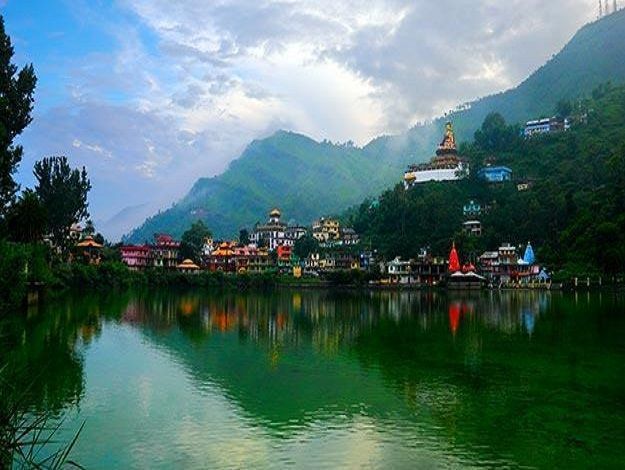
Commonly known as Tso Pema Lotus Lake, is located 22.5 from Mandi district. This mid-altitude lake is situated at an elevation of about 1,360 m above sea level. The square shape of this lake with the shoreline of about 735 m attracts thousands of tourists all year-round. The place is considered to be a sacred spot for Hindus, Sikhs and Buddhists alike. The lush greenery surrounding the crystal clear waters of this lake makes the place look even more divine.
PLACE DETAILS:
Famous for housing the second largest statue in India, Rewalsar Lake is about 24 km from Mandi in Himachal Pradesh.
The lake is shaped like a square with a shoreline of 735 m. The lake lies on a mountain spur protected by a variety of dense vegetation and is known for its floating islands of reed. It is believed that all of them can be moved by prayer or breeze.
The place is held sacred by Hindus, Sikhs and Buddhists. Legend has it that sage Padmasambhava used tantric powers to take flight from Rewalsar to Tibet to preach Buddhism. Also known as Guru Rimpoche, it was under his influence that Mahayana Buddhism took root at Rewalsar and his spirit is said to reside in the tiny islands of floating reed that drifts over the water.
The lake is shaped like a square with a shoreline of 735 m. The lake lies on a mountain spur protected by a variety of dense vegetation and is known for its floating islands of reed. It is believed that all of them can be moved by prayer or breeze.
The place is held sacred by Hindus, Sikhs and Buddhists. Legend has it that sage Padmasambhava used tantric powers to take flight from Rewalsar to Tibet to preach Buddhism. Also known as Guru Rimpoche, it was under his influence that Mahayana Buddhism took root at Rewalsar and his spirit is said to reside in the tiny islands of floating reed that drifts over the water.
It also has a gurudwara that was built in 1930 by Raja Joginder Sen of Mandi. Rewalsar has three Hindi temples which are dedicated to Lord Krishna, Lord Shiva and to the sage Lomas. There are three Buddhist monasteries at Rewalsar.
It is in Rewalsar that the sage Lomas did penance in devotion to Lord Shiva.
It is in Rewalsar that the sage Lomas did penance in devotion to Lord Shiva.
The tenth Guru of Sikhism – Guru Gobind Singh is also known to have resided in Rewalsar for about a month and the gurudwara was constructed in his honour.
The major attraction of the Rewalsar Lake is the statue of Guru Rinpoche that overlooks the lake. Also known as the second Buddha, Guru Rinpoche helped preach and spread Buddhism in Tibet and Bhutan. At 123 ft, it is the second largest statue in Himachal Pradesh and is situated nearly 4000 ft above sea level.
Other lakes situated near Rewalsar are also worth a visit. Of the six lakes, Lake of Kunt Bhayo (1750 m above sea level) shouldn’t be missed. These ancient lakes are associated with Pandavas and are called SAR which means – meaning or moral. A large number of tourists come to visit this lake due to the legend associated with it.
The forest department of Rewalsar maintains a small zoo which is also worth visiting. The Sisu fair held in late February to March and the festival of Baisakhi are important events at Rewalsar.
Guest houses, lodges and budget hotels are available. The Sikh Gurudwara also offers accommodations. All types of Indian and Tibetan cuisines are available here. Restaurants attached to hotels serve Indian, Chinese and continental delicacies. The momos are worth trying.
Guest houses, lodges and budget hotels are available. The Sikh Gurudwara also offers accommodations. All types of Indian and Tibetan cuisines are available here. Restaurants attached to hotels serve Indian, Chinese and continental delicacies. The momos are worth trying.
Rewalsar can be visited any time of the year. The best time to visit Rewalsar Lake is between March and October.
Legend of Padmasambhava and Princess Mandarava of Mandi (Zahor)
Mandarava and Padmasambhava were energetically drawn to one another. Vihardhara, fearful of the contamination of the royal bloodline and what he perceived as Mandarava's apostasy, endeavoured to have Mandarava and Padmasambhava purified by immolation through the flames of a pyre. Instead of finding their corpses incensed and charred, Vihardhara finds that the fire of the pyre has been transformed into Lake Rewalsar, out of which arises a blooming lotus that supports the unharmed Mandarava and Padmasambhava who through this manifestation of their realisation have achieved their secret names of Vajravarahiand Hayagriva, respectively, after which Vihardhara furnishes the union with his unreserved blessings.Legend has it that the great teacher Padmasambhava (Guru Rinpoche) used his enormous power to take flight to Tibet from Rewalsar. In Rewalsar, his spirit is said to reside in the tiny island of floating reed that drifts over the water.
Statue of Padmasambhava

On April 1, 2012, a monumental statue of Padmasambhava, measuring 37.5 m (123 ft), was consecrated, blessed and inaugurated by the 14th Dalai Lama. The building project was spear-headed and overseen by Wangdor Rinpoche and funded by donations. It took nearly 10 years to complete, with the foundation alone taking three years.
The statue was constructed almost entirely by hand by tradespeople from the immediate Rewalsar area and by master artists from Nepal and Bhutan. It is made primarily of cement, layered by hand over a skeleton of iron rebar, while the walls are made of hand-cut stone. Bhutanese sculptors carved intricate details into the cement while still wet. It was then painted by masters from Nepal, who finished the delicate details by hand. The building's interior is filled with traditional dzong, tsa tsas, prayer flags and medicine pills made by local craftworkers
Comments
Post a Comment